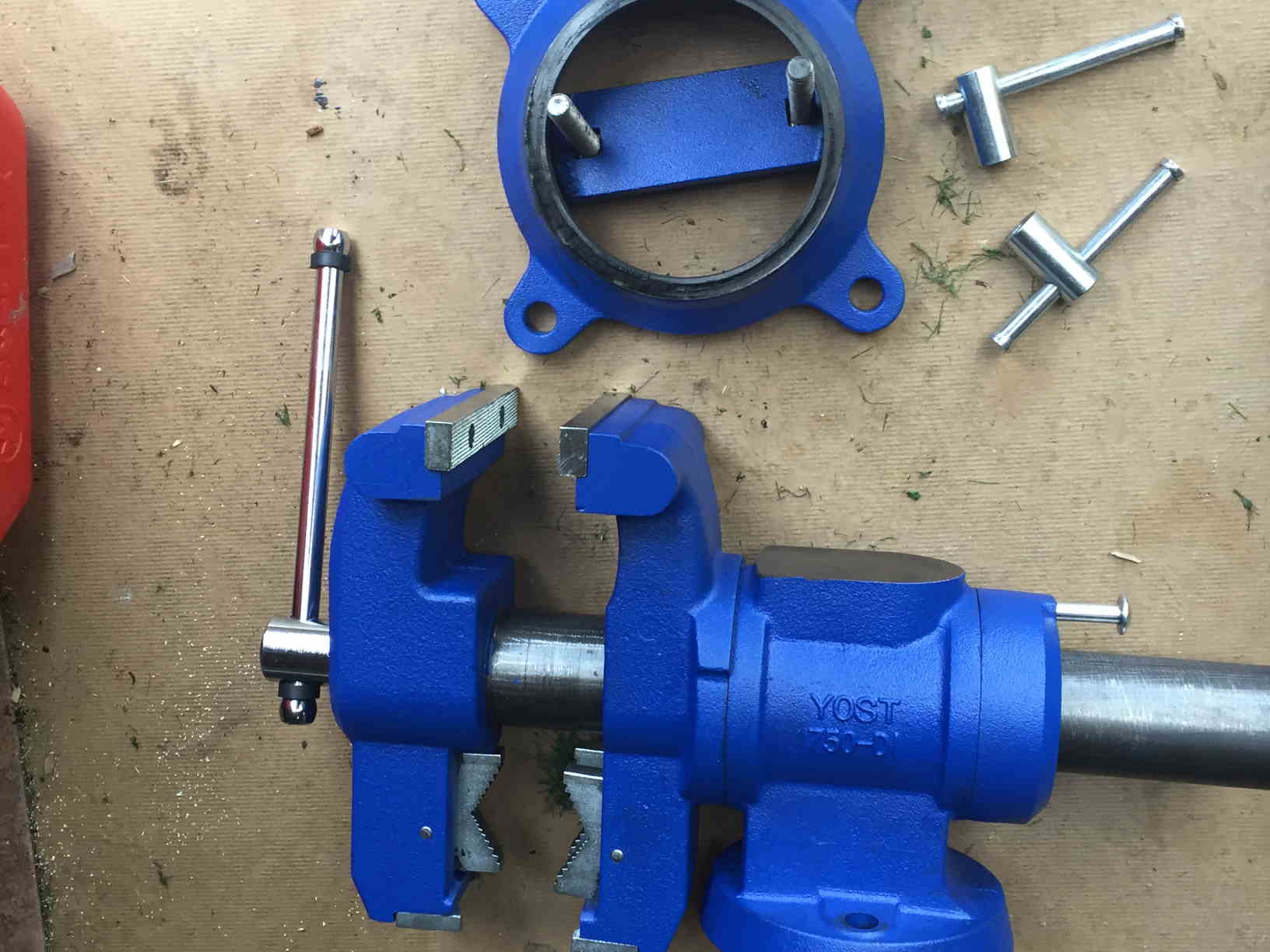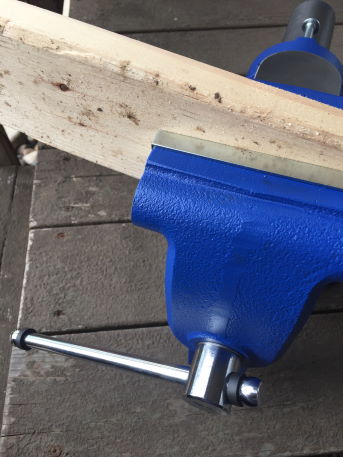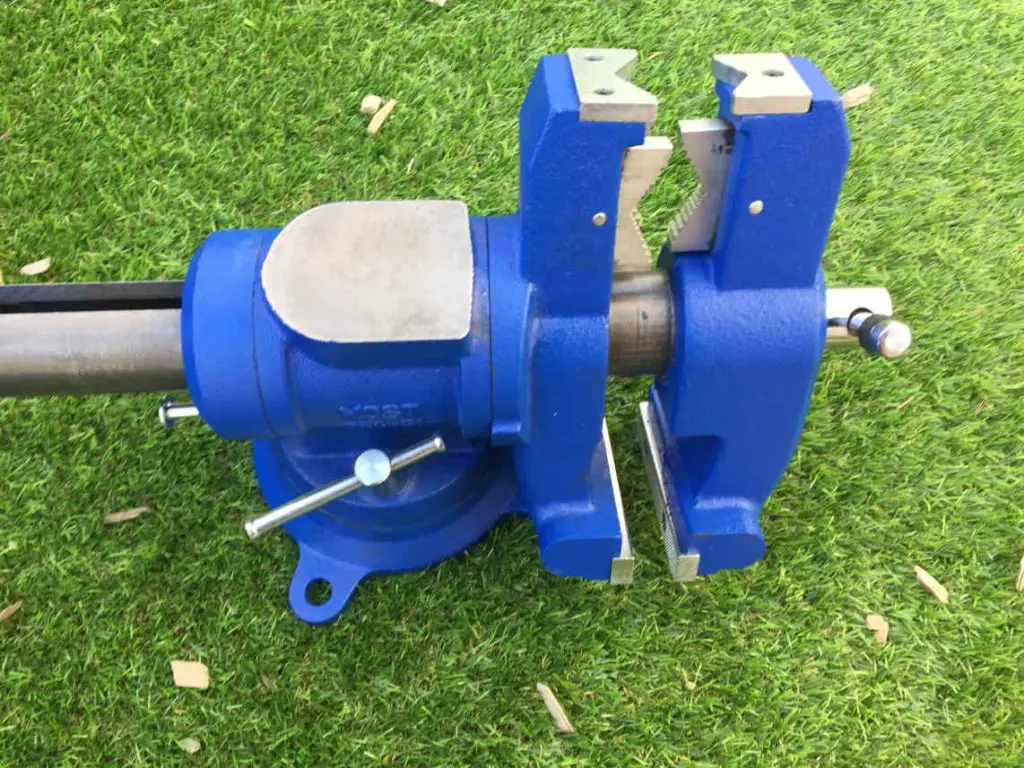
All vises serve the same function: to clamp an object in place and hold it firm while you work on it. All the different variations of vises accomplish this same task. The differences between different vises are there to help you, not stand in your way…so don’t over think it. You can use a metal working vise for woodworking and vise versa, it just might not be 100% ideal.
With that out of the way, let’s look at some of the most common variations of vise tools.
Metal Working Vise

These are the heavy duty models of the vise world. They tend to be heavier so that they can withstand the more forceful working conditions you will sometimes find when working with steel. They also tend to be made out of either cast ductile iron or forged steel. These materials make the vise stronger and more resistant to heavy workloads.
Most metal working vises will have 4 bolt holes so that they may be bolted to the table. This provides are more stable base for the vise than would be provided by a vise clamp – which is common on portable vises. Your typical metal working vise may also come with jaws that have a ridged surface on them. This ridged surface helps you hold onto slick hard metallic surfaces like steel, but it can damage softer materials like wood or plastic.
If you don’t like the jaws your vise come with, they are generally very easy to replace. And if you need a smoother/softer surface for just one job, you can find slip on covers that will minimize the damage these ridges will do to softer materials.
Because of their heavy stature, a metal working vise will often have more clamping power than a woodworking vise or a hand held vise. There is of course TREMENDOUS variability in clamping power among various models, so don’t hold this general rule too dear.
Woodworking Vises

A wood working vise is a vise designed to be used with wood (lol). They tend to be smaller, lighter, and cheaper than metal working vises – although you can buy heavy duty woodworking vises if you wish. A woodworking vise will usually have a smooth vise jaw which is sometimes made out of softer metals than what you would find in a heavy duty vise.
Another interesting point is that wood working vises are often mounted UNDER the table, unlike metal working vises which are bolted on top. A wood vise is also much more likely to use a clamping mechanism for table attachment rather than a bolting mechanism.
If you know you will only ever work with wood, and won’t ever need to work with steel, a woodworking vise can save you some money while getting the job done just as well.
Hand-Held Vises
A hand-held vise is generally much smaller than a table vise, and is great for small intricate detail work. Hand held vises are often used in conjunction with multiple simultaneous vises, both big and small. This is especially common in gluing operations where having multiple vises on one project makes it easier for two pieces of stock to be held firmly together for a long period of time.
Hand-held vises are also portable, making them convenient for field work where you can’t expect to have an immobile table everywhere you go..
Machining Vises
As the name suggests, machining vises are used for drilling, milling, or other machinery work. They are designed to help hold a piece of stock in place, and prevent the drill or mill from “catching” the stock and dangerously spinning it out of its original position.
Some machining vises will have a tilting mechanism that allows you to drill at an angle. While most machines will allow you to tilt the base platform for the same effect, it’s usually much quicker and easier to use a tilting vise than to change your machine.
Pipe Vise
A pipe vise is a vise that is designed to hold pipes. There are three common types of pipe vise. One type will have 3 serrated v shaped jaws which are brought together via a lead screw clamping a piece of pipe just like a normal vise would. Another type is a chain vise, which has 2 or more ridged jaws on the bottom, with a chain that wraps around the top of the pipe. The third type is a yoke vise. I will talk about chain vises and yoke vises in the next couple of sections.
You can buy a vise that is solely used for pipes, but there are some great multi jaw vises out there that will allow you to have both the normal vise jaws and the pipe vise jaws on one unit. This is the path I took with my yost 750-di vise.
Chain Vise
One of the problems with trying to hold a circular object (like a PVC pipe) in a normal vise is that you have to clamp down on the pipe very hard to stop it from wriggling around. This is because you don’t get enough contact area with your square vise jaws and the circular pipe.
If you clamp softer materials that tightly, you will cause distortions in the pipe, which can ruin your measurements for work. This is especially important if you have to do any kind of detailed work like threading pipes.
The way around this problem is to use a chain vise. To use a chain vise, you just set the pipe down on top of 2 V shaped serrated jaws and wrap the chain around the top. On most models you will lock the chain onto a little lip on the underside of the vise, and then tighten it with a screw mechanism of some sort.
There can be some variation on different models as to how the locking and tightening mechanism works.
Yoke Vise
Like all pipe vises, a yoke vise has a set of serrated v shaped jaws on the bottom of the vise. Above the bottom jaw is a cap that is pushed down by a screw. Yoke vises are sometimes called hinged vises or adjustable jaw vises.

Swivel Base Bench Vise
This can be thought of as more of a feature than a stand alone vise type. A swivel base just means that the vise can rotate in a circle. This can be handy for positioning, but it does makes the vise weaker to shock blows.
Quick Release Vise
This is another vise feature rather than stand alone type. A quick release vise allows you to open up the jaws quickly without having to turn the handle.
A quick release vise works by using a unlockable split nut. The split nut holds the lead screw and is located in the body of the vise. Using a a quick release mechanism (more on that below), you can can release the split nut from the screw allowing you to quickly move the dynamic jaw of the vise. When you move the jaw back into the position of the split nut, the split nut will reengage locking the vise into place.
One method for releasing the split nut involved a lever or trigger. This lever or trigger is attached to a loaded spring that releases the nut when turned.
The other common method is to have a handle that unlocks or locks the screw nut.
There is of course always a lot of overlap between the different styles of vises. As I said in the intro, they all essentially do the same thing.
Vertical Vise
This is just a vise where the jaws are tall and narrow instead of short and wide. Put another way: the vise jaws run up and down rather than left to right. They allow you to grip an object from a different angle.
Leg Vise – AKA Blacksmith Vise or Post Vise.
A blacksmith vise is a tall vise that is designed to hold hot iron while it is hammered, chiseled, or twisted. The immovable jaw is apart of a tall vertical post that is attached to the floor. It is designed to transmit shock blows down through the vise into the floor making it more resistant to shock blows. It is also designed so that if you apply hammer blows to an item in the vise, the force from those blows won’t travel into the screw that opens and closes the jaws, which is a weak point in a traditional vise for shock blows.

Pin Vise
A pin vise is a vise used for holding thin wires,pins, and cylinders. It works in a very similar fashion to a drill chuck.
Tool Maker’s Vise
A tool maker’s vise is a small little vise with plain jaws that is used to work with softer materials. It’s primary design consideration is not bruising or damaging the stock that is placed between its jaws.
Cross Slide Vise
A cross slide vise is a vise with 3 lead screws instead of 1. The first screw is used to open and close the vise jaws just like a normal vise. the second screw moves BOTH vise jaws along the x axis (left to right). The third screw moves BOTH vise jaws along the y axis (up and down). These screws are turned with a handle just like a normal vise.
The 3 screws allow you to clamp an object, and then move it along the xy plane.These vises are great when precision is needed in drilling operations. I go into more details (including pitfalls) on the cross slide vise in this article.
Reversible Vise
A reversible vise is a vise where the stationary jaw has steel plates on both sides of it’s structure. The leadscrew/slide can be taken out of a reversible vise, and then put back into place on the opposite side. This allows you to utilize the steel plates on both sides of the stationary jaw. These vises give you two different jaw opening lengths. On some models the steel plate will have a different texture (serrate vs not) on each side of the stationary jaw.
Conclusion
There is of course always a lot of overlap between the different styles of vises. As I said in the intro, they all essentially do the same thing: they clamp around an object holding it immobile so that you can work on that object. If learning about all these different vice types has you in a shopping mood, check out my guide on vises.
